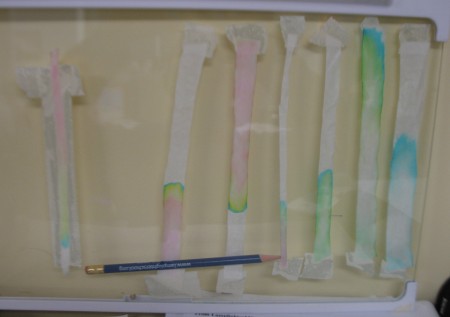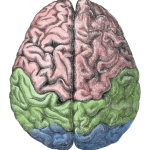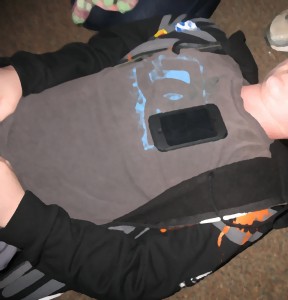Arasmus is mapping all the events that are happening in Libya. A lot of it’s confusing, things are changing very fast, and who knows where it will end up.
View Mapping Violence Against Pro-Democracy Protests in Libya in a larger map
Middle and High School … from a Montessori Point of View
Arasmus is mapping all the events that are happening in Libya. A lot of it’s confusing, things are changing very fast, and who knows where it will end up.
View Mapping Violence Against Pro-Democracy Protests in Libya in a larger map


One of the more basic techniques in the microbiologist’s toolkit is gel electrophoresis. It’s used to separate long molecules, like proteins, RNA and DNA from one another. Different organisms have different DNA sequences, so electrophoresis can be used to identify organisms and for DNA fingerprinting. Chromatography is also used to separate different molecules, usually pigments. Therefore, using some filter paper, food coloring, and popsicle sticks I created a nice little chromatographic fingerprinting lab exercise using chromatography as an analogue for electrophoresis.

Using a standard set of four food colors (red, blue, green and yellow), I grabbed each students individually and had them add three drops of the colors of their choice to a test tube with 1 ml of water in it. One students went with three straight blue drops, but most picked some mixture of colors. I kept track of the color combinations they used, and labeled their test tube with a unique, random number.
When they’d all created their own “color fingerprint” in the test tubes, I handed them back out randomly, and gave them the key of names and color combinations (but no numbers). They had to find out whose test tube they had.

I was kind enough to give them a few little demonstrations of chromatography I’d been experimenting with over the last day or so. The easiest technique is simply to place a couple drops of the sample on a filter paper (we used coffee filters “requisitioned” from the teachers lounge), and chase it with a couple drops of water to help the dye spread out. This method works, but since the sample spreads out in a circle, the inverse square law means that the separation of colors can be hard to see.
While the drop method worked well for most students, one who was a bit more analytically-minded, interested in the project, and had a particularly difficult sample, tried doing it using a filter paper column. Since I wanted to show them the proper way of conducting experiments, particularly about the importance of using standards, and I wanted to check if they were able to interpret their results correctly, I also did the full set of samples myself as columns. The standards are essential, because the green food color is actually a mixture of green and blue dyes.
Our color chromatography setup is as you see at the top of this post. We used popsicle sticks to keep the filter paper strips away from the glass surface.

The experiments worked well, and for best results, let the it dry because the colors show up better. One focus with my students was on note-taking and recording results; after a few iterations that worked out well too. Another nice aspect of using the series of columns is that it looks a lot like the electrophoresis bands.
I did try some other variants of the chromatography: top down, bottom up and even taped down. The last version, where I taped the filter paper to the glass to create a restricted column, worked very well.

Fortunately, we also know from extensive research both in the U.S. and elsewhere that when we treat teens like adults, they almost immediately rise to the challenge.
— Epstein (2007): The Myth of the Teen Brain in Scientific American Mind.
Is the angst and turmoil we usually associate with adolescence just a result of the way human brains develop, or is it something learned, and depends on the society that shapes our kids? Robert Epstein argues (Epstein, 2007) it’s the latter not the former, and, despite a lot of other research to the contrary, he may have a point. He believes the main problem is that western teens are treated more as children than young-adults, and they spend most of their time socializing with other teens and not with adults.

Alex Chediak posts a good overview of the work.
We’ve seen that one of the major problems with most psychological studies is that they only focus on WEIRD people, typically represented by college students in the Western world, who are the easiest people for university researchers to study. Using any such subset must, necessarily, be unrepresentative of the full range of human behavior. Furthermore, since society influences brain development, even studies that focus less on behavior and more on neurological imaging are likely to be affected by the some bias.
A similar argument can be made for studies of adolescence since most studies of adolescence focus on western teens. As a result, separating behavior learned via social interaction, from the regularly progression of genetically programmed brain development is going to be difficult.
Much of Epstein’s argument is based on the book Adolescence: An Anthropological Inquiry (Schlegel and Barry, 1991), which compared teens in almost 200 pre-industrial societies. Epstein summarizes this and other work to indicate that in pre-industrial cultures:
- about 60 percent had no word for “adolescence,”
- teens spent almost all their time with adults,
- teens showed almost no signs of psychopathology
- antisocial behavior in young males was completely absent in more than half these cultures and extremely mild in cultures in which it did occur.
- teen trouble begins to appear in other cultures soon after the intro- duction of certain Western influences, especially Western-style schooling, television programs and movies.
— Epstein (2007) (my bulleting): The Myth of the Teen Brain in Scientific American Mind.
As a result, teens:
learn virtually everything they know from one another rather than from the people they are about to become. Isolated from adults and wrongly treated like children, it is no wonder that some teens behave, by adult standards, recklessly or irresponsibly.

Epstein’s antidote is to treat teens like adults. I agree. However, it’s essential to keep in mind what type of adults we want them to be: responsible and logical, while retaining the creativity we usually associate with childhood. This is something that typifies the ideal of Montessori education, all the way from early-childhood up.
NYU scientists have traced the evolution of tomcod fish that’s been driven by pollution in the Hudson River. The NPR article is nice because it really breaks down how fish with the right genes preferentially survived the PCBs and dioxins in the river, and passed their genes on.
It also turns out that the fish “selected” for pollution tolerance end up being more sensitive to other things, like high water temperatures. It really puts, “survival of the fittest” in context. The fish are “fit” for polluted rivers, but not “fit” for warmer water.
I’ve long thought that with all the things we can do with personal, handheld technology that we’re acceleratingly becoming cyborgs. And I don’t think it a bad thing. Consider how much cell phones and the internet helped in the Egyptian protests. Consider being able to look up maps and definitions when you need them, and being able to share them live in the classroom.
Garry Kasparov, the chess grandmaster who was the first to be defeated by a computer in 1998, adds another useful datapoint in an article on the human-machine partnerships in chess competitions:
The teams of human plus machine dominated even the strongest computers. The chess machine Hydra, which is a chess-specific supercomputer like Deep Blue, was no match for a strong human player using a relatively weak laptop. Human strategic guidance combined with the tactical acuity of a computer was overwhelming.
–Kasparov (2010): The Chess Master and the Computer
but also fascinating is this, after a tournament:
The winner was revealed to be not a grandmaster with a state-of-the-art PC but a pair of amateur American chess players using three computers at the same time. Their skill at manipulating and “coaching” their computers to look very deeply into positions effectively counteracted the superior chess understanding of their grandmaster opponents and the greater computational power of other participants.
The take home message is worth pondering:
Weak human + machine + better process was superior to a strong computer alone and, more remarkably, superior to a strong human + machine + inferior process.
–Kasparov (2010): The Chess Master and the Computer
“It’s like finding out Santa Claus doesn’t exist.”
That was my student’s response on discovering that jacklopes do not actually exist.
She’d been planning on doing her Independent Research Project on jacklopes. She’d already invested some time in doing some internet research, and this morning she came up to me and asked, “Are jacklopes real?”

I told her they weren’t, but she had to go look them up herself in actual hardcopy, the Wildlife Fact-file binders that we keep on the reference shelf. They weren’t in there.
I offered that she could still do her IRP on jackalopes, just focusing on the cultural meanings and reasons behind the phenomenon. Also she could discuss the potentials for genetically engineered organisms.
She’s still considering it.

I’ve been hoping for a wireless keyboard for the iPhone for quite a while, and Apple has finally produced one. As far as my students are concerned, with a full keyboard to write useful amounts of text, the iPhone is almost as good as having a “normal” computer. And the same applies to the iPad as well.
Once you have the keyboard, however, he next question is, how do you get the iPhone to sit at the correct angle for you to do your work. My students have dug up a couple solutions, starting with the paperclip version you see above. Simple, cheap, and elegant; I really like it.

A couple days after seeing the paperclip stand in action, I came across the Lego stand.
“Why,” I asked.
“Because it’s awesome.”
“Oh,” I replied.
And it is.

We were working on plate tectonics last week, and the conversation went from earthquakes to heartbeats.
I think it started with the question of, “How do we know what the inside of the Earth is like if no one’s been down to see it?”
I agreed that we’ve not even been down to the bottom of the crust because the heat and pressure would collapse any hole we tried to drill. I did not mention that terrible movie, “The Core”, because beyond maybe the first ten minutes where there is some actual speculative science fiction, it’s really not worth seeing.
But beneath the crust, how do we know how thick the mantle is? How do we know that the inner core is solid metal (mostly iron) while the outer core is liquid metal?
Not wanting to go into too much detail I tried to explain about seismic waves. Different types can go through different materials and if you monitor their reflections off different parts of the Earth’s interior you can puzzle out the layering and composition. I just gave the simplest demonstration: if you tap a piece of wood with you knuckle, could you tell that it was wood and not metal? What if you tapped a bucket, could you tell if it was full of water or not? Well seismic tomography work in much the same way, except that you’re usually picking up the reverberations from the earthquake rather than making it yourself by hitting the bucket. There’s also a bit more math involved.
But tapping the bucket gives a quick easy feel (pun intended) for the process. My students at least seemed satisfied.
So then I pointed out that you could use an app called iSeismo, to detect seismic waves. Both the iPhone (and its variants) and the iPad have accelerometers that can be used to pick up motion in all three dimensions. My students from last year remembered it, and at least one already had it loaded on his phone.
A quick test showed that the phone’s pretty sensitive. You can pick up two people jumping together all the way across the room. This part of the demo is nice because it helps prove that seismic waves from earthquakes can go very far. You can also see the little squiggles as the waves are picked up.
I did not try it this time, and I’ll need to confirm if it will work, but since the time on the phones should be well synchronized over the network, and iSeismo can output the actual data, we should be able to use three iPhones to triangulate the location of the jumpers. This might work in nicely with geometry now that I think about it.

Anyway, finally, a student asked if the phone might be able to pick up his heartbeat if he lay on his back.
We tried it. Lying on his back on the floor while holding his breath, we could see his heartbeat quite clearly.